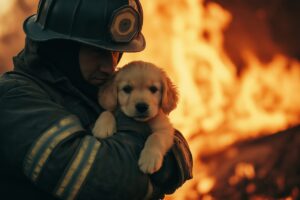 Fires are among the most destructive events that can occur in a home, threatening not only property but the lives of those inside—both human and animal. Each year, thousands of house fires affect families and their pets, yet many pet owners may not be fully prepared to respond effectively in the event of an emergency. Pets, in particular, often react to fires by panicking, hiding, or freezing, making it difficult for them to escape on their own. This puts them at extreme risk in fast-moving fires where every second counts.
Fires are among the most destructive events that can occur in a home, threatening not only property but the lives of those inside—both human and animal. Each year, thousands of house fires affect families and their pets, yet many pet owners may not be fully prepared to respond effectively in the event of an emergency. Pets, in particular, often react to fires by panicking, hiding, or freezing, making it difficult for them to escape on their own. This puts them at extreme risk in fast-moving fires where every second counts.
As a responsible pet owner, it’s crucial to have a well-thought-out and practiced fire escape plan that accounts for the safety of your furry, feathered, or scaly family members. Pets depend on us to keep them safe, so having a solid plan in place can mean the difference between life and tragedy. Here’s everything you need to know about creating and implementing a fire escape plan specifically designed to protect your pets.
Alert Rescuers About Pets in the Home
One of the simplest yet most effective ways to protect your pets during a fire is to ensure first responders are aware that animals are in the home. This knowledge allows them to prioritize locating and rescuing pets during their search.
Pet Rescue Stickers
Invest in pet rescue stickers, which can be purchased online or from most pet stores, and place them on highly visible windows or doors of your home. These stickers should include:
- The number of pets inside the home.
- The types of pets (dogs, cats, birds, reptiles, etc.).
- Any specific information that might help, such as whether a pet is crated, disabled, or requires special care.
Make it a habit to update these stickers whenever the number of pets in your home changes to give rescuers an accurate count. Always ensure firefighters and rescue workers can easily see the stickers from the outside.
Design a Fire Escape Plan
When a fire breaks out, chaos can quickly overwhelm both humans and pets. Having a concrete escape plan helps eliminate confusion and ensures everyone knows what to do in an emergency. While general fire escape safety is critical for all family members, here’s how to cater your plan specifically to the needs of pets.
Know Their Favorite Spots
 Pets tend to stick to preferred areas in the home, and in emergencies, they often retreat to these familiar spots. Make a list of your pet’s “regular spots,” including their favorite hiding places, napping spots, and areas they run to when scared.
Pets tend to stick to preferred areas in the home, and in emergencies, they often retreat to these familiar spots. Make a list of your pet’s “regular spots,” including their favorite hiding places, napping spots, and areas they run to when scared.
Locate Common Hiding Spots
Animals naturally hide under furniture, behind heavy objects, or in small, dark spaces when frightened. Survey your home and identify potential hiding spots, especially those that are hard to reach. Mark them on your fire escape plan.
Create a Home Layout
Draw a map of your home, indicating the primary escape routes, pet hiding spots, and locations of tools like leashes, carriers, or crates. This visual representation can be a lifesaver in stressful situations by helping you stay focused and efficient.
Be Prepared: Gather Essential Equipment
Time is critical during a fire—there’s no room for searching through closets or attics for your pet’s equipment. Keeping essential pet supplies organized and accessible is a vital part of any fire escape plan.
Leashes and Collars
If you have dogs, know exactly where their leashes and collars are at all times. These should be placed near exits or in a convenient, easy-to-reach area. Consider having an extra leash near your emergency exits for quick grab-and-go access.
Carriers and Crates
Small animals like cats, rabbits, and birds will need carriers or crates during an evacuation. Store these items in a specific, accessible spot—never buried in storage spaces or locked away in the back of a garage. If you care for exotic pets like reptiles or small mammals, keep a designated container ready to transport them safely.
First Aid Supplies
 Prepare a pet emergency kit equipped with essentials such as a pet first aid guide, bandages, and any medications the pet may need.
Prepare a pet emergency kit equipped with essentials such as a pet first aid guide, bandages, and any medications the pet may need.
Label Doors or Crates
If your pets are crate-trained and could be left in their crates during your absence, make sure the crates are labeled with your pet’s name and any specific medical or dietary instructions in case rescuers find them.
Practice, Practice, Practice
A fire escape plan is only effective if everyone in the household knows how to execute it—and that includes your pets! Repeatedly practicing your plan will make it second nature during an emergency, while also familiarizing your pets with what to expect.
Simulate Different Scenarios
Practice evacuation drills for fires originating in different locations, such as the kitchen, bedroom, or living room. Each scenario will require slightly different approaches, so practicing from various starting points ensures you’re prepared for any situation.
Include Pets in Drills
During drills, practice finding and evacuating your pets from their typical hiding spots. Start by running into the home, retrieving your pet, leashing or crating them, and leading them outside to a designated meeting point.
Train Dogs for Smoke Detectors
Some dogs can be trained to associate the smoke detector’s alarm with a specific behavior, such as running to an exit or gathering in a safe area. This can save valuable moments in a real emergency.
Use Escape Tools
If your home has multiple floors, practice using a fire escape ladder and determine how to carry small pets safely while descending. Ensure your equipment is sturdy, functional, and appropriate for both human and pet use.
After the Fire: Post-Evacuation Care
Once you’ve evacuated, ensure your pets remain safe and calm. Fires are traumatic, and pets may exhibit signs of stress, such as shaking, excessive panting, or hiding. Here’s how to handle the aftermath of a fire:
Check for Injuries or Smoke Inhalation
If your pet appears injured or shows signs of respiratory distress, such as coughing or difficulty breathing, take them to a veterinarian immediately.
Keep Pets Secured
Pets may try to run back toward the burning structure out of fear or confusion. Keep them on a leash or in their carrier until the area is safe.
Notify First Responders
If you couldn’t locate all of your pets during the evacuation, tell firefighters where the missing pets were last seen. Rescuers are trained to re-enter homes to search for pets.
Fire Safety Tips to Prevent House Fires
Prevention is always better than reaction. Here are a few additional tips to reduce fire risks in your home and protect your pets:
 Keep candles and open flames out of reach of pets. Cats and dogs can accidentally knock over candles, starting fires.
Keep candles and open flames out of reach of pets. Cats and dogs can accidentally knock over candles, starting fires.- Avoid using space heaters near unattended pets. Fluffy tails or curious noses can ignite from these heat sources.
- Use flameless candles or LED lights to avoid open flames altogether.
- Never leave stovetops uncovered while cooking, as pets may jump up and accidentally start a fire.
Final Thoughts: Protecting Pets in the Event of a Fire
Fires are unpredictable and dangerous, but with preparation, you can significantly increase your pet’s chances of staying safe. Taking proactive steps—like creating a fire escape plan, marking your home with pet rescue stickers, and practicing evacuation drills—ensures you’re ready to protect your furry family members in any emergency. Being prepared not only safeguards your pets’ lives but also provides invaluable peace of mind.
At Paw Pals, we’re here to support you in keeping your pets safe, healthy, and loved, even when life gets hectic. From daily pet care to overnight sitting, our trusted pet sitters are dedicated to providing reliable, professional care in Northern Virginia. Contact Paw Pals today to schedule your pet sitting services and ensure your pets are always in good hands—whether during daily routines or unexpected emergencies. Remember, preparation and care save lives!


